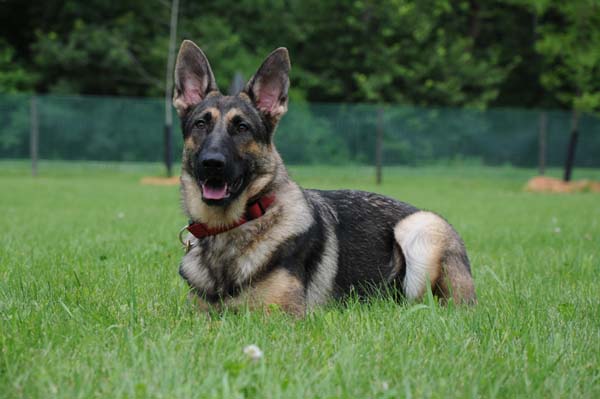German Shepherd puppy biting is one of the key behaviors you should take charge of as soon as possible.
Ignoring or encouraging biting behavior can lead to it spinning out of control. And once your puppy is older biting could mean big problems… Like puncture wounds, legal battles, confiscation or worse – euthanasia.
Keep in mind that your German Shepherd puppy will one day be a strong and muscular dog. Adult males can weigh anywhere between 30 – 40 kg (66 – 88 lbs) and females between 22 – 32 kg (49 – 71 lbs).
And they have a powerful scissor-like bite exerting more than 1060 Newtons or 238 lbf of force. Trying to control the strong bite of an adult dog could end in disaster for you and your dog.
Before we look at how to take charge of your German Shepherd puppy biting we should first understand a few key things about biting…
Behavior or Temperament
It’s important for you to realize the difference between behavior and temperament…
- Puppy biting is a behavior and it’s something all puppies do.
- The reason for puppy biting is temperament. Certain dog breeds are more prone to biting than others.
Biting is normal
Yes, biting is a normal behavior for puppies and dogs. I mean think about it… If a dog is upset, he’s not going to hire an attorney and sue you! No, he’s going to bite.
It’s our responsibility to teach our dogs not to bite through training.
Exploring
Puppies explore their environment through their mouths, very much like human babies do. Your puppy will put anything in his mouth, including your fingers and limbs!
Puppies SHOULD bite
Shock, horror! You read that right, puppies should bite.
Right now you’re thinking:
Hang on Rosemary! I thought you just said it’s my responsibility to teach my German Shepherd puppy NOT to bite…
But stay with me here…
Puppies should bite so that they CAN learn that biting hurts. It’s the exact same way they’d learn that biting hurts if they were biting other puppies in a play session.
You should use your German Shepherd’s natural biting behavior as a training opportunity.
Before we get to the good stuff, I’d like to highlight the BIGGEST mistake I see a lot of owners make…
Don’t expect your puppy to know what you want him to do unless you teach him first!
For example: it’s unfair to yell at your puppy when he bites you during a play session if you’ve never taught him not to bite.
If you do, the result will be that your pup won’t bite YOU anymore. But he’ll still bite other members of the family, visitors or even the postman.
Playing is very important for you and your puppy and you should be able to play. But there have to be boundaries. What you don’t want is a puppy that has a habit of mouthing that becomes harder and harder as your puppy grows stronger.
So how do you inhibit German Shepherd puppy biting?
During Play Sessions
The best time to do this is during a play session between you and your puppy.
I suggest initiating play sessions with your puppy as often as possible until you have taught your puppy to have a soft mouth. Here are the steps you should follow to teach your puppy what the appropriate behavior is…
1. Allow your puppy to mouth your finger or hand during play.
2. The moment he bites down too hard or applies any pressure yelp out the word ‘ouch!’.
3. Immediately get up and walk away.
To begin with your puppy might not use his mouth, but as he becomes more and more aroused he’ll be more likely to bite down. The moment he does so, play should stop.
This is one of those training session where using a lot of tactile praise is good. This reminds your pup that you still love him. It’s only the hard biting that you’re not happy about.
Redirect to something appropriate
Redirecting your puppy’s mouthing onto something more appropriate by using toys. Some puppies will prefer soft toys while others will prefer something rubbery like a kong toy. Other puppies might not like soft or rubbery toys but rather a rope toy. Only buy purchasing some of these toys will you learn which you puppy likes best.
Kong toys are great because you can fill one end with something delicious your puppy loves. I use organic peanut butter. But you can use treats or even a portion of your puppy’s meal.
It’s important to note here that your puppy should never be left unsupervised with toys.
Eureka! The Soft Mouth
After a few tries he’ll have his ‘eureka’ moment and start being a lot more gentle. This is called mouthing or a ‘soft mouth’.
Mouthing means gentle play with the mouth and no hard biting or pressure.
With mouthing it’s important to remember that only you control mouthing. You initiate mouthing and you decide when it stops.
Here are 4 rules to simplify the steps to German Shepherd puppy biting control…
4. Rules to German Shepherd puppy biting inhibition
#1 Only YOU initiate play
#2 No Hard Biting
#3 No Pressure Allowed
#4 Controlled Mouthing
The key take aways here are:
- Your German Shepherd puppy’s natural instinct to bite sets the stage for the perfect training opportunity.
- Your puppy won’t know what you want (or don’t) want him to do unless you teach him first.
- Use play sessions to take charge of your German Shepherd puppy biting.
- Always apply the 4 rules to puppy biting inhibition.







